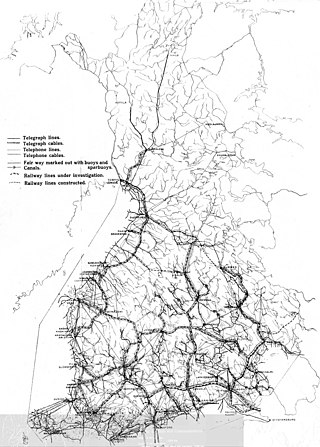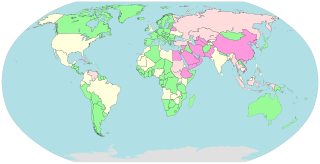
Telecommunications in Finland, as indicated by a 2022 European Commission index, highlight the country's significant role in the EU's digital sector. Finland has a high concentration of Information and Communication Technology (ICT) specialists and robust training programs, leading to notable expertise in technologies like AI and cloud computing. The nation has also made significant advancements in 5G technology. Additionally, Finland stands out for its high adoption of digital public services. The Finnish digital sector benefits from both the technology industry's contributions and government policies aimed at enhancing digital infrastructure and cybersecurity.
Telecommunications in Greenland include radio, television, fixed and mobile telephones, and the Internet.
Telecommunications in Austria encompass highly developed and efficient internet and telephone networks, complemented by a number of radio and television broadcast stations.

The Pirate Bay is an online index of digital content of entertainment media and software. Founded in 2003 by Swedish think tank Piratbyrån, The Pirate Bay allows visitors to search, download, and contribute magnet links and torrent files, which facilitate peer-to-peer, file sharing among users of the BitTorrent protocol.

Use of the Internet in Yemen began in 1996 through the ISPs TeleYemen and the Public Telecommunications Corporation. By July 2016, 6,732,928 people were Internet users.

Mexico has approximately 81 million Internet users representing 70.1% of the population. The country ranks 10 in number of Internet users in the world. Mexico is the country with the most Internet users among Spanish speaking countries and is currently experiencing a huge surge in demand for broadband Internet services. In August 2005, Cisco Systems, said they see Mexico and countries in Latin America as the focal point for growth in coming years. With Mexico being identified as a hypergrowth market for equipment suppliers and receiving the biggest chunk of Cisco's investments. Additionally looking at the historical growth for the period from 2001 to 2005 we see broadband Internet jump from 0.1 subscribers per hundred population to 2.2 subscribers per hundred population, a growth of 2100% in just five years.
According to research done by the Organisation for Economic Co-operation and Development (OECD), the Netherlands is ranked with Switzerland in having the most broadband subscriptions per 100 inhabitants, has no bandwidth caps, and has the most homes passed in Europe in terms of connection speeds of 50 Mbit/s and higher.

The internet is an important contributor to Ireland's economy and education. The telecommunications infrastructure in Ireland provides Internet access to businesses and home users in various forms, including fibre, cable, DSL, wireless, Fixed Wireless and mobile. In 2019, 91% of households have access to the Internet in Ireland at home, with 88% of individuals reporting that they had used the internet in the three months prior to interview.
Internet in Malta plays a key role in enhancing the nation's digital infrastructure and public services.
The Internet in Croatia became a reality in November 1992 when the first international connection linking Zagreb and Vienna became operational.
The Internet in Greece relied on PSTN/ISDN modem dial-up from 1990 until 2003, when ADSL was commercially launched by the incumbent operator OTE. ADSL2+, VDSL2 and GPON are currently the main broadband standards in Greece. It has 3G, 4G, 4G+ and 5G mobile broadband (HSPA) and a more expensive Satellite Internet access. It also has an extensive fiber-optic network throughout the country.
The Internet in Norway is available through Fiber or Mobile. The country code top level domain is .no.
Internet in Portugal reached an 88% household penetration rate in 2022, with notably higher access rates in households with children. Among individuals aged 16 to 74, mobile internet use is prevalent, at 81.8%, primarily for communication and information access.
This article is about the Internet in Spain.

The term "Internet in Poland" refers to various aspects related to the state of the Internet in the Republic of Poland. This encompasses issues such as Internet access, governance, freedom, and infrastructure, as well as social, economic, and political factors that contribute to the digital landscape in Poland.
Use of the Internet in Venezuela has greatly expanded, but is mostly concentrated among younger, educated city residents, and centered on the capital, Caracas. According to several experts, the lack of quality Internet in Venezuela, which includes the slowest speed in Latin America and one of the slowest Internet speeds in the world, is due to the poor infrastructure of the country.
Internet in Estonia has one of the highest penetration rates in the world. In the first quarter of 2010, 75% out of 1.34 million people in the country used the Internet according to Statistics Estonia. In 2017, according to the World Bank came 13th in the world by the percentage of population using the Internet, with 88.1% people using it.
Telecommunications in Denmark encompasses a well-developed network of internet, telephone services, and broadcasting stations. Denmark has high internet connectivity and widespread mobile broadband adoption.

PirateBrowser is an Internet browser by The Pirate Bay used to circumvent Internet censorship.

This list of Internet censorship and surveillance in Europe provides information on the types and levels of Internet censorship and surveillance that is occurring in countries in Europe.






